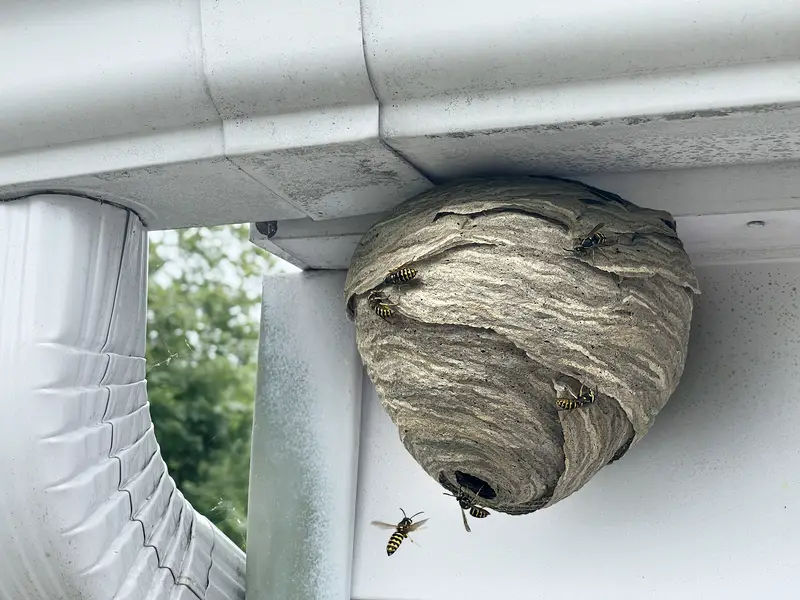Have you ever spotted a wasp nest in your yard and thought about grabbing a match to solve the problem? You’re not alone. Many homeowners think fire is a quick fix for getting rid of unwanted wasp nests. But this common idea can lead to some seriously scary situations. I once heard from a neighbor who tried this method and ended up with a swollen face, multiple painful stings, and a small fire in his yard that nearly spread to his shed. The truth is, there are some really good reasons why fire and wasp nests don’t mix, and knowing them could save you from a world of pain.
Wasps become extremely aggressive when threatened
Wasps are not the type to back down from a fight, especially when their home is under attack. When you try to burn their nest, you’re essentially declaring war on the entire colony. Unlike bees, which can only sting once, wasps can sting multiple times in a row. And here’s the scary part – when wasps feel threatened, they release alarm pheromones that signal other wasps to join the attack. This chemical message spreads quickly through the colony, turning what might have been just a few upset wasps into an angry swarm ready to defend their home at all costs.
The heat and smoke from fire cause wasps to become extremely agitated and defensive. Instead of killing them instantly as you might hope, burning often drives them out of the nest in a panic – right toward you. Many people don’t realize that wasps can still fly and sting even when parts of their nest are on fire. Their first instinct is to attack whatever is threatening them, which means you become their target. Even if you think you’re standing at a safe distance, wasps can fly several feet in seconds when they’re in attack mode, leaving you little time to escape.
The nest material is highly flammable
Wasp nests are basically nature’s perfect kindling. They’re made primarily of wood fibers that wasps collect from trees, fences, and even cardboard. The wasps chew these fibers and mix them with their saliva to create a paper-like material that burns extremely quickly. When you set fire to a wasp nest, you’re essentially lighting a paper lantern – except this one is filled with angry insects. The fire can spread much faster than expected, quickly getting out of control. And because many nests are built in hidden spots like wall voids, attics, or trees, the fire can easily spread to surrounding structures before you even realize what’s happening.
The danger increases depending on where the nest is located. If it’s attached to your house, shed, or wooden fence, the fire can quickly spread to these structures. Even nests that appear to be in “safe” locations like trees can cause serious problems, as burning debris can fall and ignite dry grass or leaves below. In dry conditions, this can lead to a rapidly spreading fire. What started as an attempt to solve a simple pest problem can quickly turn into a much more serious emergency requiring fire extinguishers or even firefighters.
Burning doesn’t kill all the wasps
One of the biggest misconceptions about burning a wasp nest is that it will wipe out the entire colony in one go. Unfortunately, this rarely happens. Wasps build their nests with multiple escape routes, and many will flee at the first sign of smoke or heat. Some wasps are likely to be away from the nest when you attack it, foraging for food or materials. When these survivors return and find their home destroyed, they don’t just give up and fly away – they often stick around the area, more aggressive than ever. They may even begin to rebuild the nest nearby, sometimes in a less visible location where you won’t notice until the colony has grown larger.
Even worse, if the queen survives (and they’re often protected deep within the nest), she can start a new colony very quickly. Queens are the reproductive members of the colony and can lay hundreds of eggs. If she escapes the burning nest, she may establish a new nest in your yard within days. This means your burning attempt not only failed to solve the problem but may have made it worse by splitting one wasp colony into two or more smaller colonies. Now instead of dealing with one nest, you might find yourself facing multiple nests, with wasps that are already primed to be defensive after their previous home was attacked.
The risk of multiple painful stings is serious
Wasp stings hurt – a lot. Unlike bee stings, which contain mellittin, wasp venom contains a cocktail of pain-inducing chemicals that can cause intense burning and swelling. When wasps attack, they rarely stop at just one sting. A single wasp can sting multiple times, injecting venom with each painful jab. Now imagine dozens or even hundreds of wasps all attacking at once, and you can see why this is such a dangerous situation. The pain from multiple stings can be overwhelming, causing people to panic, which often leads to falls or other injuries as they try to escape the angry swarm.
For some people, the danger goes far beyond pain. About 3% of adults are allergic to wasp venom, and for them, even a single sting can trigger a life-threatening reaction called anaphylaxis. Symptoms can include throat swelling, difficulty breathing, dizziness, and a dangerous drop in blood pressure. Even if you’ve never had an allergic reaction before, it’s possible to develop one at any time. Multiple stings increase this risk substantially. Emergency services may not be able to reach you quickly enough if you have a severe reaction, especially if you’re in a remote location. Having an emergency epinephrine injector nearby can be lifesaving, but prevention is always the better option.
Property damage can be extensive
The potential for property damage when burning a wasp nest extends far beyond just scorching a small area. Fire is unpredictable, especially when it involves a nest that might be larger than you can see from the outside. Many wasp nests are built in walls, attics, or other hidden spaces where the fire can spread unseen. By the time you notice smoke coming from unexpected places, the fire may have already caused significant structural damage. Even outdoor nests can cause problems – a nest in a tree can lead to the entire tree catching fire, which can then spread to nearby structures or other vegetation.
The financial cost of this damage can be substantial. Home insurance policies often don’t cover damage caused by intentionally set fires that get out of control, meaning you could be stuck with the repair bills. Beyond your own property, there’s the risk of the fire spreading to neighboring homes or land. This could leave you legally liable for damages to others’ property as well. Even a small fire can cause thousands of dollars in damage, making the cost of professional wasp removal seem like a bargain by comparison. The potential for serious property damage makes burning a wasp nest one of the most expensive ways to deal with the problem.
Safer removal methods exist
With all the risks associated with burning wasp nests, you’ll be happy to know there are much safer alternatives. Professional pest control services have the proper equipment and training to remove wasp nests safely. They use specialized insecticides that can kill the entire colony quickly, and they know how to apply these treatments with minimal risk to themselves or your property. While hiring professionals might seem expensive at first glance, it’s much cheaper than dealing with the potential consequences of a DIY removal gone wrong. Many companies offer guarantees on their work, ensuring that if the wasps return, they’ll come back to handle the problem at no additional cost.
If you’re determined to handle the problem yourself, there are safer DIY options than fire. Wasp spray products are designed specifically for this purpose and can be used from a safe distance. The best time to deal with a nest is early morning or after sunset when most wasps are inside the nest and less active due to cooler temperatures. Always wear protective clothing, including long sleeves, pants, gloves, and a face mask. Have a clear escape route planned before you start, and never attempt removal if you’re allergic to wasp stings. Remember that even with these precautions, DIY removal still carries risks that professional services don’t.
Prevention is better than removal
The best way to deal with wasp nests is to prevent them from being built in the first place. Wasps start building new nests in spring, so this is a key time to be vigilant. Regular checks around your property can help you spot new nests while they’re still small and easier to deal with. Focus on areas like eaves, porches, sheds, and trees. Seal any cracks or holes in your home’s exterior to prevent wasps from building nests inside walls or attics. Keep outdoor garbage cans tightly closed, as food waste can attract wasps. Consider using fake wasp nests, which fool wasps into thinking the territory is already claimed.
Interestingly, leaving old, empty wasp nests in place during winter can actually help prevent new colonies from forming. Wasps rarely reuse old nests, and the presence of an old nest can signal to new queens that the area may not be suitable for a new colony. Of course, you should only leave nests that you’re sure are completely abandoned. If you notice wasp activity around your home, try using wasp traps to reduce their numbers before they can establish a nest. These traps use bait to lure wasps inside, where they become trapped and eventually die, helping to keep the population under control without the risks associated with nest removal.
Know when to call in the professionals
There are certain situations where it’s definitely time to call in professional help rather than attempting any kind of DIY removal. If the nest is very large (bigger than a basketball), it likely contains hundreds or even thousands of wasps, making it extremely dangerous to approach. Nests located in hard-to-reach areas like inside walls, high up in trees, or in confined spaces like attics or crawl spaces also require professional handling. These locations make it difficult to treat the nest properly and can increase the risk of fire or injury. If you’ve already tried to remove the nest and the wasps have become aggressive, stop immediately and call for professional help.
Another clear sign that you need professional help is if anyone in your household has a known allergy to wasp stings. The risk is simply too high to justify any type of DIY removal. Most professional pest control companies offer emergency services for dangerous wasp situations, so don’t hesitate to call even outside of normal business hours if you’re dealing with an immediate threat. When choosing a pest control service, look for companies with specific experience in wasp nest removal and check reviews from previous customers. Make sure they offer a guarantee on their work and ask about their methods to ensure they use safe, effective treatments.
When it comes to dealing with wasp nests, the risks of burning far outweigh any possible benefits. From aggressive wasps to property damage and personal injury, fire creates more problems than it solves. Instead, opt for professional removal or safer DIY methods, and focus on prevention to keep these stinging insects from setting up home near yours in the first place. Your safety, and that of your family and neighbors, is worth the extra effort to handle these pests properly.

